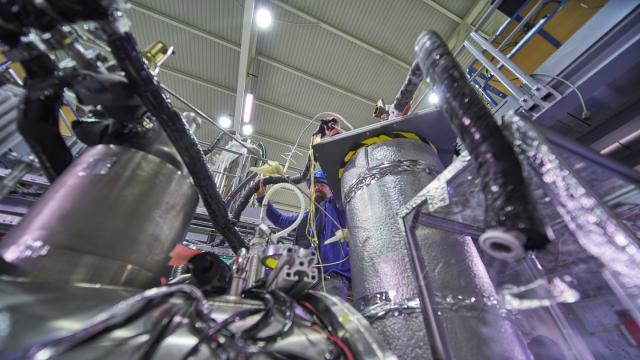If physics were complete as-is, the Universe wouldn’t exist. All particles would have found their antiparticle pairs and annihilated into a burst of energy. Matter and antimatter look like exact mirror images of one another, after all. There’s no difference between a particle and its antiparticle partner aside from having the reverse value of some of their intrinsic properties — they’re like mirror images.
Image: CERN
Yet here we are, living lumps of regular matter reading blog posts on the internet, while antimatter only exists in some very specific cases, like in our experiments or as a product of some kinds of radioactive decay. A team of living lumps in Switzerland are one of many measuring the most fundamental properties of nature, hoping to find some difference between those of matter and antimatter.
On the way, they have measured a single property of the proton’s antiparticle partner, called the antiproton, to mind-boggling precision. It’s so precise that it’s even more precise than the same value for the more abundant and well-known proton. They haven’t found a difference, but they’re not upset yet.
“I’m in fact very happy that we achieved this,” said Stefan Ulmer, the spokesperson of the Baryon Antibaryon Symmetry Experiment (BASE) collaboration at CERN in Switzerland told Gizmodo. “This is one of the most difficult measurements that have ever been carried out in a Penning trap,” a device that uses magnetic and electric fields to store particles.
So, what’s antimatter? Every fundamental particle, every electron, proton, and quark (the proton sub-parts) has an accompanying antiparticle, according to scientists’ observations. These antiparticles have the exact same mass and the exact opposite electrical charge from what scientists have measured. Scientists can’t explain why there should be so much more matter than antimatter in our Universe, which is why they carry out measurements at experiments like BASE.

The researchers were specifically studying the proton and the antiproton’s magnetic moment. This measurement is basically just what happens when you put the particle into a magnetic field and watch how it twists to align itself in the same way a bar magnet aligns itself when you put it near another bar magnet. It’s an innate number built into the fabric of the laws of particle physics; it’s similar to the way that you come with intrinsic properties built into your identities, such as a name and a favourite food.
Making this kind of measurement is no small feat. First, CERN’s antimatter factory, its Antiproton Decelerator, must slow the antimatter down to low enough energies for scientists to make a precision measurement. Then they have to trap it in a vacuum equivalent to that of the depths of space between stars — otherwise, the antiproton might find another particle to annihilate with. Then they observe how the particle moves in the electric and magnetic fields of the traps, using the measurements to calculate the magnetic moment.
The number they got for the antiproton was −2.7928473441(42)μN, where μN is equal to another fundamental constant (like pi or e) divided by the proton’s mass. The most precise measurement of the proton’s number was almost exactly the same but with the opposite sign, +2.792847350(9)μN, according to the paper published in Nature.
This is science, so both of those numbers have a spread of possible answers, represented by the numbers in parentheses — think of the parentheses as me saying “give or take a few seconds” after saying “Danielle was born on February 17, 1980, at 3:14:15 pm ET.” If you said Danielle was born the same day but at 3:15 ET, give or take a few minutes, we’d say our measurements were the same, but mine was more precise.
If this is still too many numbers for you, just think — the picture the team took of the antiproton revealed an exact mirror image of the proton’s, but one that’s even clearer. And at least for this magnetic moment value, the image is really freaking clear.
“It’s hard to appreciate how truly difficult it is to do what they do. I’m completely impressed by what these guys have done,” Jeffery Hangst, spokesperson of a different antimatter experiment hooked up to the Antiproton Decelerator called ALPHA, told Gizmodo. “This is really a work of art, this one.”
Everyone is excited about the measurement, but you’re right in thinking that we still don’t know why there’s so much more matter than antimatter. And physicists are using lots of experiments to measure the fabric of the Universe to find an answer. Whoever does find an answer will probably win a Nobel prize. And all that these guys can really do is continue to look and refine their experiments, hoping to find some anomaly.
Ulmer said: “We now have ideas to improve this measurement by a factor of 100”
